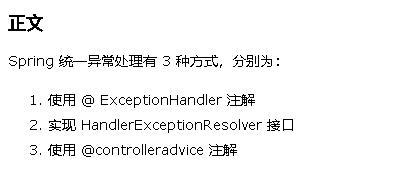继承 ResponseEntityExceptionHandler 类来实现针对 Rest 接口 的全局异常捕获,并且可以返回自定义格式:
复制代码
1 @Slf4j
2 @ControllerAdvice
3 public class ExceptionHandlerBean extends ResponseEntityExceptionHandler {
4
5 /**
6 * 数据找不到异常
7 * @param ex
8 * @param request
9 * @return
10 * @throws IOException
11 */
12 @ExceptionHandler({DataNotFoundException.class})
13 public ResponseEntity<Object> handleDataNotFoundException(RuntimeException ex, WebRequest request) throws IOException {
14 return getResponseEntity(ex,request,ReturnStatusCode.DataNotFoundException);
15 }
16
17 /**
18 * 根据各种异常构建 ResponseEntity 实体. 服务于以上各种异常
19 * @param ex
20 * @param request
21 * @param specificException
22 * @return
23 */
24 private ResponseEntity<Object> getResponseEntity(RuntimeException ex, WebRequest request, ReturnStatusCode specificException) {
25
26 ReturnTemplate returnTemplate = new ReturnTemplate();
27 returnTemplate.setStatusCode(specificException);
28 returnTemplate.setErrorMsg(ex.getMessage());
29
30 return handleExceptionInternal(ex, returnTemplate,
31 new HttpHeaders(), HttpStatus.OK, request);
32 }
33
34 }
复制代码
转:
https://www.cnblogs.com/junzi2099/p/7840294.html
spring处理异常的三种方式:

对于与数据库相关的 Spring MVC 项目,我们通常会把 事务 配置在 Service层,当数据库操作失败时让 Service 层抛出运行时异常,Spring 事物管理器就会进行回滚。
如此一来,我们的 Controller 层就不得不进行 try-catch Service 层的异常,否则会返回一些不友好的错误信息到客户端。但是,Controller 层每个方法体都写一些模板化的 try-catch 的代码,很难看也难维护,特别是还需要对 Service 层的不同异常进行不同处理的时候。例如以下 Controller 方法代码(非常难看且冗余):
/**
* 手动处理 Service 层异常和数据校验异常的示例
* @param dog
* @param errors
* @return
*/
@PostMapping(value = "")
AppResponse add(@Validated(Add.class) @RequestBody Dog dog, Errors errors){
AppResponse resp = new AppResponse();
try {
// 数据校验
BSUtil.controllerValidate(errors);
// 执行业务
Dog newDog = dogService.save(dog);
// 返回数据
resp.setData(newDog);
}catch (BusinessException e){
LOGGER.error(e.getMessage(), e);
resp.setFail(e.getMessage());
}catch (Exception e){
LOGGER.error(e.getMessage(), e);
resp.setFail("操作失败!");
}
return resp;
}- 本文讲解使用 @ControllerAdvice + @ExceptionHandler 进行全局的 Controller 层异常处理,只要设计得当,就再也不用在 Controller 层进行 try-catch 了!而且,@Validated 校验器注解的异常,也可以一起处理,无需手动判断绑定校验结果 BindingResult/Errors 了!
一、优缺点
- 优点:将 Controller 层的异常和数据校验的异常进行统一处理,减少模板代码,减少编码量,提升扩展性和可维护性。
- 缺点:只能处理 Controller 层未捕获(往外抛)的异常,对于 Interceptor(拦截器)层的异常,Spring 框架层的异常,就无能为力了。
二、基本使用示例
2.1 @ControllerAdvice 注解定义全局异常处理类
@ControllerAdvice
public class GlobalExceptionHandler {
}请确保此 GlobalExceptionHandler 类能被扫描到并装载进 Spring 容器中。
2.2 @ExceptionHandler 注解声明异常处理方法
@ControllerAdvice
public class GlobalExceptionHandler {
@ExceptionHandler(Exception.class)
@ResponseBody
String handleException(){
return "Exception Deal!";
}
}- 1
- 2
- 3
- 4
- 5
- 6
- 7
- 8
- 9
方法 handleException() 就会处理所有 Controller 层抛出的 Exception 及其子类的异常,这是最基本的用法了。
被 @ExceptionHandler 注解的方法的参数列表里,还可以声明很多种类型的参数,详见文档。其原型如下:
@Target(ElementType.METHOD)
@Retention(RetentionPolicy.RUNTIME)
@Documented
public @interface ExceptionHandler {
/**
* Exceptions handled by the annotated method. If empty, will default to any
* exceptions listed in the method argument list.
*/
Class<? extends Throwable>[] value() default {};
}- 1
- 2
- 3
- 4
- 5
- 6
- 7
- 8
- 9
- 10
- 11
- 12
如果 @ExceptionHandler 注解中未声明要处理的异常类型,则默认为参数列表中的异常类型。所以上面的写法,还可以写成这样:
@ControllerAdvice
public class GlobalExceptionHandler {
@ExceptionHandler()
@ResponseBody
String handleException(Exception e){
return "Exception Deal! " + e.getMessage();
}
}- 1
- 2
- 3
- 4
- 5
- 6
- 7
- 8
- 9
参数对象就是 Controller 层抛出的异常对象!
三、处理 Service 层上抛的业务异常
有时我们会在复杂的带有数据库事务的业务中,当出现不和预期的数据时,直接抛出封装后的业务级运行时异常,进行数据库事务回滚,并希望该异常信息能被返回显示给用户。
3.1 代码示例
封装的业务异常类:
public class BusinessException extends RuntimeException {
public BusinessException(String message){
super(message);
}
}- 1
- 2
- 3
- 4
- 5
- 6
Service 实现类:
@Service
public class DogService {
@Transactional
public Dog update(Dog dog){
// some database options
// 模拟狗狗新名字与其他狗狗的名字冲突
BSUtil.isTrue(false, "狗狗名字已经被使用了...");
// update database dog info
return dog;
}
}- 1
- 2
- 3
- 4
- 5
- 6
- 7
- 8
- 9
- 10
- 11
- 12
- 13
- 14
- 15
- 16
- 17
其中辅助工具类 BSUtil
public static void isTrue(boolean expression, String error){
if(!expression) {
throw new BusinessException(error);
}
}- 1
- 2
- 3
- 4
- 5
那么,我们应该在 GlobalExceptionHandler 类中声明该业务异常类,并进行相应的处理,然后返回给用户。更贴近真实项目的代码,应该长这样子:
/**
* Created by kinginblue on 2017/4/10.
* @ControllerAdvice + @ExceptionHandler 实现全局的 Controller 层的异常处理
*/
@ControllerAdvice
public class GlobalExceptionHandler {
private static final Logger LOGGER = LoggerFactory.getLogger(GlobalExceptionHandler.class);
/**
* 处理所有不可知的异常
* @param e
* @return
*/
@ExceptionHandler(Exception.class)
@ResponseBody
AppResponse handleException(Exception e){
LOGGER.error(e.getMessage(), e);
AppResponse response = new AppResponse();
response.setFail("操作失败!");
return response;
}
/**
* 处理所有业务异常
* @param e
* @return
*/
@ExceptionHandler(BusinessException.class)
@ResponseBody
AppResponse handleBusinessException(BusinessException e){
LOGGER.error(e.getMessage(), e);
AppResponse response = new AppResponse();
response.setFail(e.getMessage());
return response;
}
}- ontroller 层的代码,就不需要进行异常处理了:
@RestController
@RequestMapping(value = "/dogs", consumes = {MediaType.APPLICATION_JSON_UTF8_VALUE})
public class DogController {
@Autowired
private DogService dogService;
@PatchMapping(value = "")
Dog update(@Validated(Update.class) @RequestBody Dog dog){
return dogService.update(dog);
}
}- 1
- 2
- 3
- 4
- 5
- 6
- 7
- 8
- 9
- 10
- 11
- 12
3.2 代码说明
Logger 进行所有的异常日志记录。
@ExceptionHandler(BusinessException.class) 声明了对 BusinessException 业务异常的处理,并获取该业务异常中的错误提示,构造后返回给客户端。
@ExceptionHandler(Exception.class) 声明了对 Exception 异常的处理,起到兜底作用,不管 Controller 层执行的代码出现了什么未能考虑到的异常,都返回统一的错误提示给客户端。
备注:以上 GlobalExceptionHandler 只是返回 Json 给客户端,更大的发挥空间需要按需求情况来做。
四、处理 Controller 数据绑定、数据校验的异常
在 Dog 类中的字段上的注解数据校验规则:
@Data
public class Dog {
@NotNull(message = "{Dog.id.non}", groups = {Update.class})
@Min(value = 1, message = "{Dog.age.lt1}", groups = {Update.class})
private Long id;
@NotBlank(message = "{Dog.name.non}", groups = {Add.class, Update.class})
private String name;
@Min(value = 1, message = "{Dog.age.lt1}", groups = {Add.class, Update.class})
private Integer age;
}- 1
- 2
- 3
- 4
- 5
- 6
- 7
- 8
- 9
- 10
- 11
- 12
- 13
说明:@NotNull、@Min、@NotBlank 这些注解的使用方法,不在本文范围内。如果不熟悉,请查找资料学习即可。
其他说明:
@Data 注解是 **Lombok** 项目的注解,可以使我们不用再在代码里手动加 getter & setter。
在 Eclipse 和 IntelliJ IDEA 中使用时,还需要安装相关插件,这个步骤自行Google/Baidu 吧!
- 1
- 2
- 3
- 4
- 5
- 6
Lombok 使用方法见:Java奇淫巧技之Lombok
SpringMVC 中对于 RESTFUL 的 Json 接口来说,数据绑定和校验,是这样的:
/**
* 使用 GlobalExceptionHandler 全局处理 Controller 层异常的示例
* @param dog
* @return
*/
@PatchMapping(value = "")
AppResponse update(@Validated(Update.class) @RequestBody Dog dog){
AppResponse resp = new AppResponse();
// 执行业务
Dog newDog = dogService.update(dog);
// 返回数据
resp.setData(newDog);
return resp;
}使用 @Validated + @RequestBody 注解实现。
当使用了 @Validated + @RequestBody 注解但是没有在绑定的数据对象后面跟上 Errors 类型的参数声明的话,Spring MVC 框架会抛出 MethodArgumentNotValidException 异常。
所以,在 GlobalExceptionHandler 中加上对 MethodArgumentNotValidException 异常的声明和处理,就可以全局处理数据校验的异常了!加完后的代码如下:
/**
* Created by kinginblue on 2017/4/10.
* @ControllerAdvice + @ExceptionHandler 实现全局的 Controller 层的异常处理
*/
@ControllerAdvice
public class GlobalExceptionHandler {
private static final Logger LOGGER = LoggerFactory.getLogger(GlobalExceptionHandler.class);
/**
* 处理所有不可知的异常
* @param e
* @return
*/
@ExceptionHandler(Exception.class)
@ResponseBody
AppResponse handleException(Exception e){
LOGGER.error(e.getMessage(), e);
AppResponse response = new AppResponse();
response.setFail("操作失败!");
return response;
}
/**
* 处理所有业务异常
* @param e
* @return
*/
@ExceptionHandler(BusinessException.class)
@ResponseBody
AppResponse handleBusinessException(BusinessException e){
LOGGER.error(e.getMessage(), e);
AppResponse response = new AppResponse();
response.setFail(e.getMessage());
return response;
}
/**
* 处理所有接口数据验证异常
* @param e
* @return
*/
@ExceptionHandler(MethodArgumentNotValidException.class)
@ResponseBody
AppResponse handleMethodArgumentNotValidException(MethodArgumentNotValidException e){
LOGGER.error(e.getMessage(), e);
AppResponse response = new AppResponse();
response.setFail(e.getBindingResult().getAllErrors().get(0).getDefaultMessage());
return response;
}
}注意到了吗,所有的 Controller 层的异常的日志记录,都是在这个 GlobalExceptionHandler 中进行记录。也就是说,Controller 层也不需要在手动记录错误日志了。
五、总结
本文主要讲 @ControllerAdvice + @ExceptionHandler 组合进行的 Controller 层上抛的异常全局统一处理。
其实,被 @ExceptionHandler 注解的方法还可以声明很多参数,详见文档。
@ControllerAdvice 也还可以结合 @InitBinder、@ModelAttribute 等注解一起使用,应用在所有被 @RequestMapping 注解的方法上,详见搜索引擎。